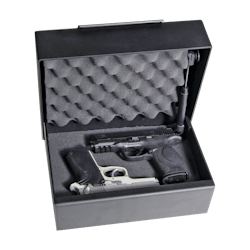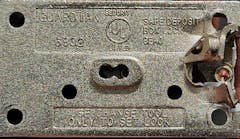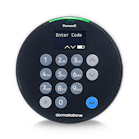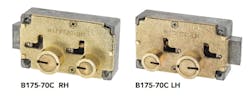The challenge for an effective handgun safe is keeping pistols and short revolvers safely locked away from unauthorized users, yet within easy reach of the owner, who may need immediate access in an emergency situation.
Unlike larger gun safes, the handgun safe is almost always kept with arms’ reach. This means the handgun safe will be located under or attached to the bed frame, in or on adjacent furniture or between the mattresses. Some handgun safes include a security cable to secure the safe to a fixed object. Many of these safes have mounting holes.
Even within close proximity, the handgun safe's lock mechanism must be relatively easy to operate in the less than ideal conditions such as in the dark and under stress.
Handgun safes are built in different configurations. Some safes are a container with a removable or hinged lid along the top or the front. A version of the top-mounted lid is the drawer safe. Others have a tilt-out compartment where the container is bolted against a fixed object.
Depending upon the safe manufacturer, handgun safes are constructed from different thicknesses of steel. Smaller, less expensive models may have a 2mm steel body and 6mm steel door. On the other extreme, the Fort Knox Auto Pistol Box is constructed 3/16"-door with a 10-gauge body steel.
Safe Lock Options
Less expensive pistol safes are usually equipped with a double-sided or keyed tubular locks. The keyed lock requires the authorized person to gain access to the key, insert it in the correct position and operate the locking mechanism, which can be quite difficult during a high stress situation.
Other options are three-wheel combination locks, four- or five-button pushbutton locks (mechanical or electromechanical) or fingerprint recognition locks.
With three-wheel combination locks, each wheel must be rotated to a number between 0-9. In a dark room, light will probably be required to read the dials. Once the combination has been dialed, the knob is rotated to release the lid. This type of sub-compact safe is very small designed for one pistol or revolver.
Mechanical or electromechanical pushbutton locks require pressing the combination in the proper sequence. Some handgun safes are equipped with a Simplex-style mechanical five-pushbutton lock. Latch retraction occurs once the correct combination has been entered and the knob is rotated. No power or batteries are required for the mechanical pushbutton locks. The mechanical pushbutton lock combination can be changed by the authorized user.
Electromechanical pushbutton locks are the next option. These battery powered locks automatically release once the correct combination has been entered. The location of the pushbutton varies by design and manufacturer. Some handgun safes have a fingerpad that positions the tips of the fingers directly above the pushbuttons to enter the combination. The electromechanical pushbutton lock combination can be changed by the authorized user. Note: Some pushbutton lock-equipped safes have a key override lock in case the batteries die or the combination is lost.
Fingerprint recognition is the next level of security. Depending upon the manufacturer, the fingerprint recognition software can accommodate up to 120 fingerprints. There are two styles of fingerprint readers/sensors. The swipe model that requires the finger to slide over the reader surface and the static finger print reader/sensor that requires the finger to be placed and kept motionless on the sensor array surface.
To unlock a fingerprint recognition safe with a swipe reader, the activation button is pressed, and the finger that has already been programmed is swiped over the sensor in the same direction as it was programmed. To unlock a fingerprint recognition safe with a fixed location fingerprint reader, the programmed finger is positioned over the sensor and the activation button is pressed. The finger must be placed onto the sensor array in the same position as it was programmed.
Fingerprint readers can have problems with False Rejects Rates (FRR) and False Accuracy Rates (FAR). A false reject occurs when a programmed person’s fingerprint is rejected, keeping the safe locked. A false accuracy occurs when a person whose fingerprint has not been programmed is accepted, unlocking the safe.
The Gun Vault MVB500's self-learning algorithm adds new information to the fingerprint templates each time a programmed user operates the finger print scanner. This helps to decrease the likelihood of False Reject Rates even over time.
To ensure the fingerprint unlocks, program the same finger a number of times so that, when there is an emergency, the print will be acceptable. This means positioning the finger slightly to the left and right as well as up or down. If there is only one authorized user, program the one finger in a number of different positions.
Safe Features & Models
Handgun safe features vary by manufacturer and may include:
- Spring-loaded door that springs open and remains open after it is unlocked. Interior courtesy light for viewing valuables.
- Warnings when the batteries need replacing.
- Tamper indicators and system shutdown after invalid keypad entries. Mounting brackets.
Important: If you sell a handgun safe in California, the unit must be approved by the California Department of Justice.
The following are examples of the handgun safes from different manufacturers.
AMSEC
The AMSEC PS1210HD quick access pistol box is equipped with a Simplex five-button mechanical lock with a pry-resistant locking bolt. The welded continuous hinged top opening door is constructed of 3/16" thick steel. The body is manufactured of 10 gauge steel. Four pre-drilled bolt down holes are in the base of the body. This “Made in the USA” safe has a charcoal gray textured finish with chrome hardware.
Fort Knox
The front/top opening Fort Knox Auto Pistol Box is manufactured using 10 gauge steel body and a 3/16" thick steel door. A Simplex style pushbutton lock provides the locking mechanism. Dimensions of the Fort Knox PB Compact are 4" high by 9" wide by 6" deep. A 20-pound, 12" deep model is also available, large enough to secure a tablet. Both pistol safes have four pre-drilled mounting holes that are covered by protective caps when in the front open position.
GunVault
GunVault has a number of different handgun safes ranging from the key-operated NanoVault to Biometric MiniVault and the Speed Vault. The NanoVault NV100 is compact, measuring 9.5" long by 6.5" wide by 1.75" tall. It is manufactured of 21 gauge steel and comes with a security cable.
The GVB1000 MiniVault Biometric Handgun Safe is manufactured of 16 gauge steel, with inside dimensions of 3" tall by 7" wide by 10" deep. The fixed location fingerprint reader accepts up to 30 fingerprint identifications. The GunVault GVB1000 is powered by a 9Volt alkaline battery. An AC adapter is included.
A variation of the Handgun Safe is the GunVault SpeedVault, available with a pushbutton lock or fingerprint reader. The SV500 surface-mounted unit that has a four-button electromechanical lock mechanism with a tubular override lock. When the proper code is entered, the lower portion of the SpeedVault tilts out, providing access to the handgun. All GunVault products have a black finish. Note: NanoVaults are not Department of Justice Approved for firearms in the State of California.
Sentry
Sentry offers two basic types of handgun safes: the front opening strong box style and the new top lid handgun box. The strong box style is available in sizes ranging from 0.7 cu. ft. to 1.2 cu. ft. The X031 is key-operated with the four other models equipped with electronic keypad-operated locks. The latest are the Sentry Pistol Safes, the QAP1E and the biometric version, the QAP1BE. Both pistol boxes have a battery powered backlit four button keypad electromechanical lock with key override. These 0.8 cu. ft. safes have pry resistant doors equipped with a compression gas strut that opens the door and holds it open. The biometric fingerprint model stores up to four fingerprints.
Stack-On
Stack-On manufactures gun related enclosures including rifle safes, strong boxes, portable handgun safes and personal cases/boxes. The Stack-On PC650 handgun safe has a single three- to eight-digit electronic combination lock with key override lock. The seven pound, portable case is 11" wide by 8.5" deep x 2-1/4" high. The PC650 weighs 9 pounds. Note: This box is not Department of Justice Approved for firearms in the State of California.
VLine
The "Brute" is the new pistol box from VLine. This 22-pound handgun safe is manufactured from 10 gauge steel body and cover with a 12 gauge handle and a welded tip continuous hinge. The clamshell design lid overshadows the body providing forced entry protection. The five-button Simplex style lock operates the lock block and 1" by ½" deadbolt locking mechanism with ½" inch throw. A gas assisted opening strut provides opening assistance. Inside dimensions are 12" long by 9" wide by 3.25" tall. There are four pre-drilled 5/16" diameter holes. The “Brute” is finished in a tactical black powder coating.
For More Information
For a complete listing of safe and safelock manufacturers and distributors, visit our Locksmith Ledger 2014 Security Register on Online Buyers Guide at www.locksmithledger.com/directory. Below are phone numbers and web sites for manufacturers listed in this article.
AMSEC: 800-421-6142, www.amsecusa.com
Fort Knox: 800-821-5216, www.ftknox.com
GunVault: 800-242-1055, www.gunvault.com
Sentry: 800-828-1438, www.sentrysafe.com
Stack-On: 800-323-9601, www.stack-on.com
VLine: 805-520-4987, www.vlineind.com






